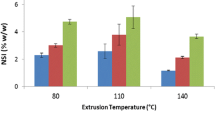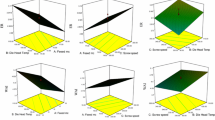Abstract
Distillers dried grains with solubles (DDGS), a feed coproduct from the fuel ethanol industry, has been shown to be a viable potential alternative protein source for aquaculture feeds. To investigate this, three isocaloric (3.5kcal/g) ingredient blends containing 20, 30, and 40% DDGS, with a net protein adjusted to 28% (wet basis, wb), were prepared for use as Nile tilapia feed. Extrusion processing was then conducted using three DDGS contents (20, 30, and 40%, wb), three moisture contents (15, 20, and 25%, wb), three barrel temperature gradients (90–100–100°C, 90–130–130°C, and 90–160–160°C), and five screw speeds (80, 100, 120, 140, and 160rpm) using a single screw laboratory extruder. Several processing parameters, including mass flow rate, net torque required, specific mechanical energy consumption, apparent viscosity, and temperature and pressure of the dough inside the barrel and die, were measured to quantify the extrusion behavior of the DDGS-based blends. For all blends, as the temperature profile increased, mass flow rate exhibited a slight decrease, die pressure decreased, and apparent viscosity exhibited a slight decrease as well. Likewise, the net torque requirement, specific mechanical energy consumption, and apparent viscosity decreased as screw speed increased, but mass flow rate increased. Additionally, as moisture content increased, die pressure decreased. At higher temperatures in the barrel and die, the viscosity of the dough was lower, leading to lower torque and specific mechanical energy requirements. Increasing the DDGS content, on the other hand, resulted in a higher mass flow rate and decreased pressure inside the die. As demonstrated in this study, the selection of suitable temperature and moisture content levels are critical for processing DDGS-based ingredient blends.





Similar content being viewed by others
References
AACC International (2000). Approved methods of the American association of cereal chemists (10th ed.). St. Paul. Minnesota, USA: The Association.
AOAC International (2003). Official methods of analysis of AOAC international (17th ed.). Gaithersburg, Massachusetts, USA: AOAC International.
BBI (2008) U.S. production capacity. Existing plants. BBI International. Retrieved 08 January 2008 from http://www.ethanolproducer.com/plant-list.jsp.
Bouvier, M. H., Fayard, G., & Clayton, J. T. (1987). Flow rate and heat transfer modeling in extrusion cooking of soy protein. Journal of Food Engineering, 6(2), 123–141.
Chen, A. H., Jao, Y. C., Larkin, J. W., & Goldstein, W. E. (1978). Rheological methods for soy dough in extrusion. Journal of Food Process Engineering, 2, 337–342.
Chevanan, N., Rosentrater, K. A., & Muthukumarappan, K. (2005a). Physical properties of extruded tilapia feed with distillers dried grains with solubles. ASABE Paper No. 056169. Proceedings of ASAE Annual International Meeting, 17–20 July 2005, Tampa, Florida, USA.
Chevanan, N., Rosentrater, K. A., & Muthukumarappan, K. (2005b). Utilization of distillers dried grains for fish feed by extrusion technology—A review. ASABE Paper No. 056025. Proceedings of ASAE Annual International Meeting, 17–20 July, Tampa, Florida, USA.
Chin, H. K., Joseph, A. M., & Jeffery, T. M. (1989). Properties of extruded dried distillers grains (DDG) and flour blends. Journal of Food Processing and Preservation, 13, 219–231.
Eerikainen, T., & Linko, P. (1989). Extrusion cooking modeling, control and optimization. In C. Mercier, P. Linko, & J. M. Harper (Eds.) Extrusion cooking (pp. 157–204). St. Paul, Minnesota, USA: American Association of Cereal Chemists Inc.
El-Sayed, A. M., & Teshima, S. (1992). Protein and energy requirements of Nile tilapia Oreochromis niloticus fry. Aquaculture, 103, 55–63.
Harmann, D. V., & Harper, J. M. (1974). Modeling a forming food extruder. Journal of Food Science, 39, 1099–1104.
Harper, J. M. (1981). Extrusion of foods, Vol. 1 & 2. Boca Raton, Florida, USA: CRC Press Inc.
Harper, J. M., Rhodes, T. P., & Wanninger, L. A. (1971). Viscosity model for cooked cereal dough. AIChE Symposium Series, 67(108), 40–43.
Jao, Y. C., Chen, A. H., Lewandowski, D., & Irwin, W. E. (1978). Engineering analysis of soy dough rheology in extrusion. Journal of Food Process Engineering, 2, 97–112.
Kokini, J. L., Chang, C. N., & Lai, L. S. (1992). The role of rheological properties of extrudate expansion. In J. L. Kokini, C. T. Ho, & M. V. Karwe (Eds.) Food extrusion science and technology (pp. 631–652). New York, USA: Marcel Dekker.
Konkoly, A. M. (1997). Rheological characterization of commercially available cream cheese and physical properties of corn and peanut composite flour extrudates. M.S. thesis. Department of Agricultural Engineering, Iowa State University, Ames, Iowa, USA.
Lam, C. M. D. (1996). Effects of processing parameters and material on fish feed extrusion with momentum transfer consideration. M.S. thesis. Department of Agricultural Engineering, Iowa State University, Ames, Iowa, USA.
Lam, C. M. D., & Flores, R. A. (2003). Effect of particle size and moisture content on viscosity of fish feed. Cereal Chemistry, 80, 20–24.
Lo, T. L., & Moreira, R. G. (1996). Product quality modeling of twin screw extrusion process. Proceedings of Annual meeting of Institute of Food Technologists, 12–16 July 1996, Chicago, Illinois, USA.
Luxenburg, L. A., Baird, D. G., & Joseph, E. G. (1985). Background studies in the modeling of extrusion cooking processes for soy flour doughs. Biotechnology Progress, 1, 33–38.
Martelli, F. G. (1983). Twin screw extruders: A basic understanding. New York, USA: Van Nostrand Reinhold.
Mercier, C., Linko, P., & Harper, J. M. (1989). Extrusion cooking. St. Paul, Minnesota, USA: American Association of Cereal Chemists Inc.
RFA (2008) Ethanol industry outlook 2007. Washington, D.C.: Renewable Fuels Association. Retrieved 08 January 2008 from http://www.ethanolrfa.org/industry/locations/.
Remsen, C. H., & Clark, J. P. (1978). A viscosity model for cooking dough. Journal of Food Process Engineering, 2, 39–64.
Rogers, M. G. (1970). Rheological interpretation of Brabender Plati-Corder (extruder head) data. Industrial Engineering Chemistry Process Design and Development, 9, 49–52.
Rosentrater, K. A., Richard, T. L., Bern, C. J., & Flores, R. A. (2005). Small scale extrusion of corn masa by-products. Cereal Chemistry, 82(4), 436–446.
Wu, Y. V., Rosati, R. R., Sessa, D. J., & Brown, B. P. (1994). Utilization of protein rich ethanol co-products from corn in tilapia feed. Journal of American Oil Chemists Society, 71(9), 1041–1043.
Wu, Y. V., Rosati, R. R., Sessa, D. J., & Brown, B. P. (1996). Effects of diets containing various levels of protein and ethanol coproducts from corn on growth of tilapia fry. Journal of Agriculture and Food Chemistry, 44, 1491–1493.
Acknowledgments
We thankfully acknowledge the financial support provided by the Agricultural Experiment Station, South Dakota State University, and the North Central Agricultural Research Laboratory, USDA-ARS, Brookings, SD.
Mention of a trade name, propriety product or specific equipment does not constitute a guarantee or warranty by the United States Department of Agriculture and does not imply approval of a product to the exclusion of others that may be suitable.
Author information
Authors and Affiliations
Corresponding author
Rights and permissions
About this article
Cite this article
Chevanan, N., Rosentrater, K.A. & Muthukumarappan, K. Effects of Processing Conditions on Single Screw Extrusion of Feed Ingredients Containing DDGS. Food Bioprocess Technol 3, 111–120 (2010). https://doi.org/10.1007/s11947-008-0065-y
Received:
Accepted:
Published:
Issue Date:
DOI: https://doi.org/10.1007/s11947-008-0065-y




